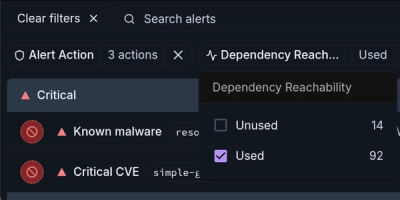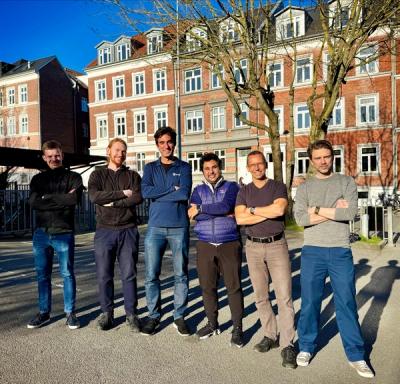
Product
Introducing Module Reachability: Focus on the Vulnerabilities That Matter
Module Reachability filters out unreachable CVEs so you can focus on vulnerabilities that actually matter to your application.

Normalized Cut, aka. spectral clustering, is a graphical method to analyze data grouping in the affinity eigenvector space. It has been widely used for unsupervised segmentation in the 2000s.
Nyström Normalized Cut, is a new approximation algorithm developed for large-scale graph cuts, a large-graph of million nodes can be processed in under 10s (cpu) or 2s (gpu).
https://github.com/user-attachments/assets/f0d40b1f-b8a5-4077-ab5f-e405f3ffb70f
conda install pytorch torchvision torchaudio pytorch-cuda=11.8 -c pytorch -c nvidia
ncut-pytorchpip install ncut-pytorchIn case of pip install failed, please try install the build dependencies
Option A:
sudo apt-get update && sudo apt-get install build-essential cargo rustc -yOption B:
conda install rust -c conda-forgeOption C:
curl --proto '=https' --tlsv1.2 -sSf https://sh.rustup.rs | sh && . "$HOME/.cargo/env"Minimal example on how to run NCUT:
import torch
from ncut_pytorch import NCUT, rgb_from_tsne_3d
model_features = torch.rand(20, 64, 64, 768) # (B, H, W, C)
inp = model_features.reshape(-1, 768) # flatten
eigvectors, eigvalues = NCUT(num_eig=100, device='cuda:0').fit_transform(inp)
tsne_x3d, tsne_rgb = rgb_from_tsne_3d(eigvectors, device='cuda:0')
eigvectors = eigvectors.reshape(20, 64, 64, 100) # (B, H, W, num_eig)
tsne_rgb = tsne_rgb.reshape(20, 64, 64, 3) # (B, H, W, 3)
Any backbone model works as plug-in feature extractor. We have implemented some backbone models, here is a list of available models:
from ncut_pytorch.backbone import list_models
print(list_models())
[
'SAM2(sam2_hiera_t)', 'SAM2(sam2_hiera_s)', 'SAM2(sam2_hiera_b+)', 'SAM2(sam2_hiera_l)',
'SAM(sam_vit_b)', 'SAM(sam_vit_l)', 'SAM(sam_vit_h)', 'MobileSAM(TinyViT)',
'DiNOv2reg(dinov2_vits14_reg)', 'DiNOv2reg(dinov2_vitb14_reg)', 'DiNOv2reg(dinov2_vitl14_reg)', 'DiNOv2reg(dinov2_vitg14_reg)',
'DiNOv2(dinov2_vits14)', 'DiNOv2(dinov2_vitb14)', 'DiNOv2(dinov2_vitl14)', 'DiNOv2(dinov2_vitg14)',
'DiNO(dino_vits8_896)', 'DiNO(dino_vitb8_896)', 'DiNO(dino_vits8_672)', 'DiNO(dino_vitb8_672)', 'DiNO(dino_vits8_448)', 'DiNO(dino_vitb8_448)', 'DiNO(dino_vits16_448)', 'DiNO(dino_vitb16_448)',
'Diffusion(stabilityai/stable-diffusion-2)', 'Diffusion(CompVis/stable-diffusion-v1-4)', 'Diffusion(stabilityai/stable-diffusion-3-medium-diffusers)',
'CLIP(ViT-B-16/openai)', 'CLIP(ViT-L-14/openai)', 'CLIP(ViT-H-14/openai)', 'CLIP(ViT-B-16/laion2b_s34b_b88k)',
'CLIP(convnext_base_w_320/laion_aesthetic_s13b_b82k)', 'CLIP(convnext_large_d_320/laion2b_s29b_b131k_ft_soup)', 'CLIP(convnext_xxlarge/laion2b_s34b_b82k_augreg_soup)',
'CLIP(eva02_base_patch14_448/mim_in22k_ft_in1k)', "CLIP(eva02_large_patch14_448/mim_m38m_ft_in22k_in1k)",
'MAE(vit_base)', 'MAE(vit_large)', 'MAE(vit_huge)',
'ImageNet(vit_base)'
]
import torch
from ncut_pytorch import NCUT, rgb_from_tsne_3d
from ncut_pytorch.backbone import load_model, extract_features
model = load_model(model_name="SAM(sam_vit_b)")
images = torch.rand(20, 3, 1024, 1024)
model_features = extract_features(images, model, node_type='attn', layer=6)
# model_features = model(images)['attn'][6] # this also works
inp = model_features.reshape(-1, 768) # flatten
eigvectors, eigvalues = NCUT(num_eig=100, device='cuda:0').fit_transform(inp)
tsne_x3d, tsne_rgb = rgb_from_tsne_3d(eigvectors, device='cuda:0')
eigvectors = eigvectors.reshape(20, 64, 64, 100) # (B, H, W, num_eig)
tsne_rgb = tsne_rgb.reshape(20, 64, 64, 3) # (B, H, W, 3)
import os
from ncut_pytorch import NCUT, rgb_from_tsne_3d
from ncut_pytorch.backbone_text import load_text_model
os.environ['HF_ACCESS_TOKEN'] = "your_huggingface_token"
llama = load_text_model("meta-llama/Meta-Llama-3.1-8B").cuda()
output_dict = llama("The quick white fox jumps over the lazy cat.")
model_features = output_dict['block'][31].squeeze(0) # 32nd block output
token_texts = output_dict['token_texts']
eigvectors, eigvalues = NCUT(num_eig=5, device='cuda:0').fit_transform(model_features)
tsne_x3d, tsne_rgb = rgb_from_tsne_3d(eigvectors, device='cuda:0')
# eigvectors.shape[0] == tsne_rgb.shape[0] == len(token_texts)
paper in prep, Yang 2024
AlignedCut: Visual Concepts Discovery on Brain-Guided Universal Feature Space, Huzheng Yang, James Gee*, Jianbo Shi*,2024
Normalized Cuts and Image Segmentation, Jianbo Shi and Jitendra Malik, 2000
FAQs
Normalized Cut and Nyström Approximation
We found that ncut-pytorch demonstrated a healthy version release cadence and project activity because the last version was released less than a year ago. It has 1 open source maintainer collaborating on the project.
Did you know?

Socket for GitHub automatically highlights issues in each pull request and monitors the health of all your open source dependencies. Discover the contents of your packages and block harmful activity before you install or update your dependencies.

Product
Module Reachability filters out unreachable CVEs so you can focus on vulnerabilities that actually matter to your application.

Company News
Socket is bringing best-in-class reachability analysis into the platform — cutting false positives, accelerating triage, and cementing our place as the leader in software supply chain security.

Product
Socket is introducing a new way to organize repositories and apply repository-specific security policies.